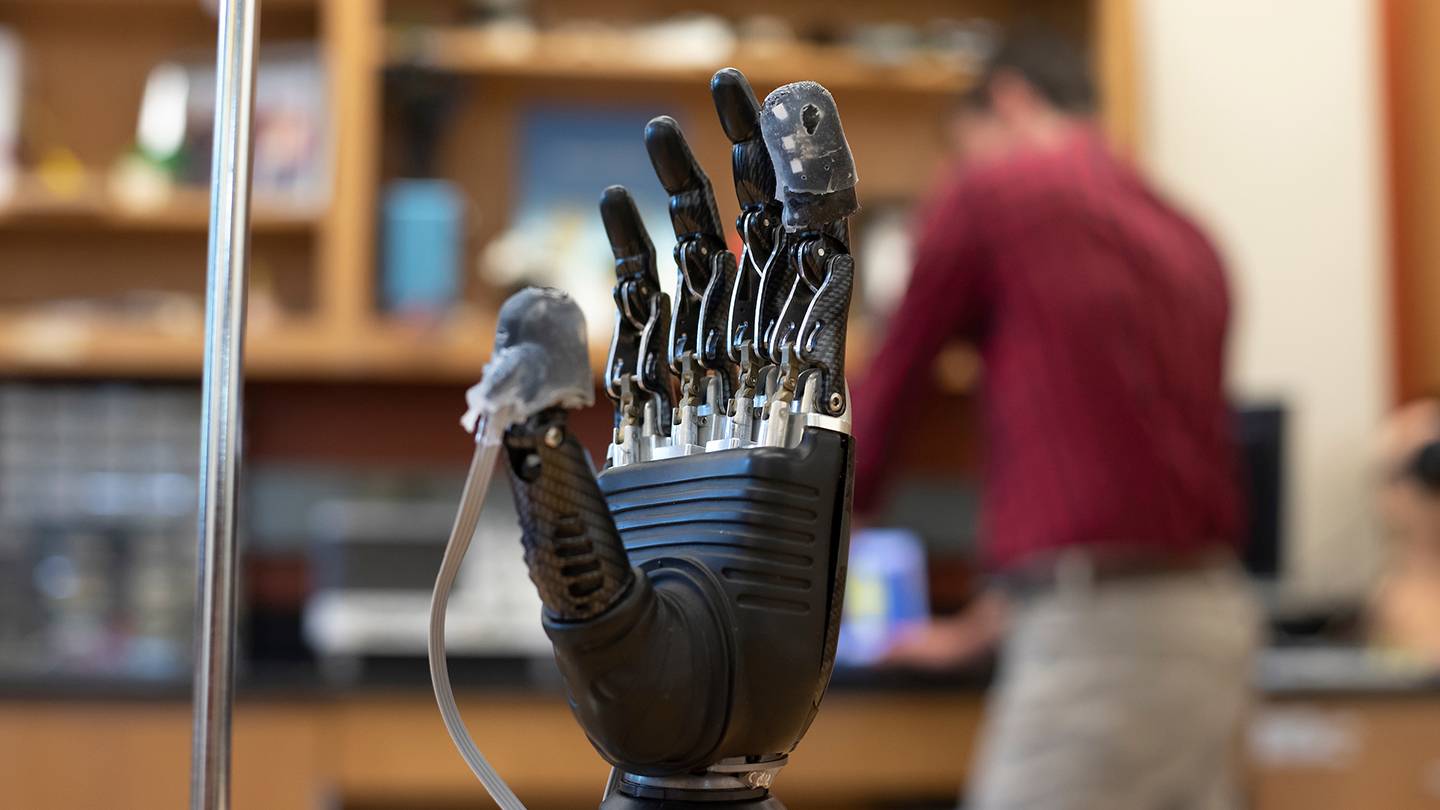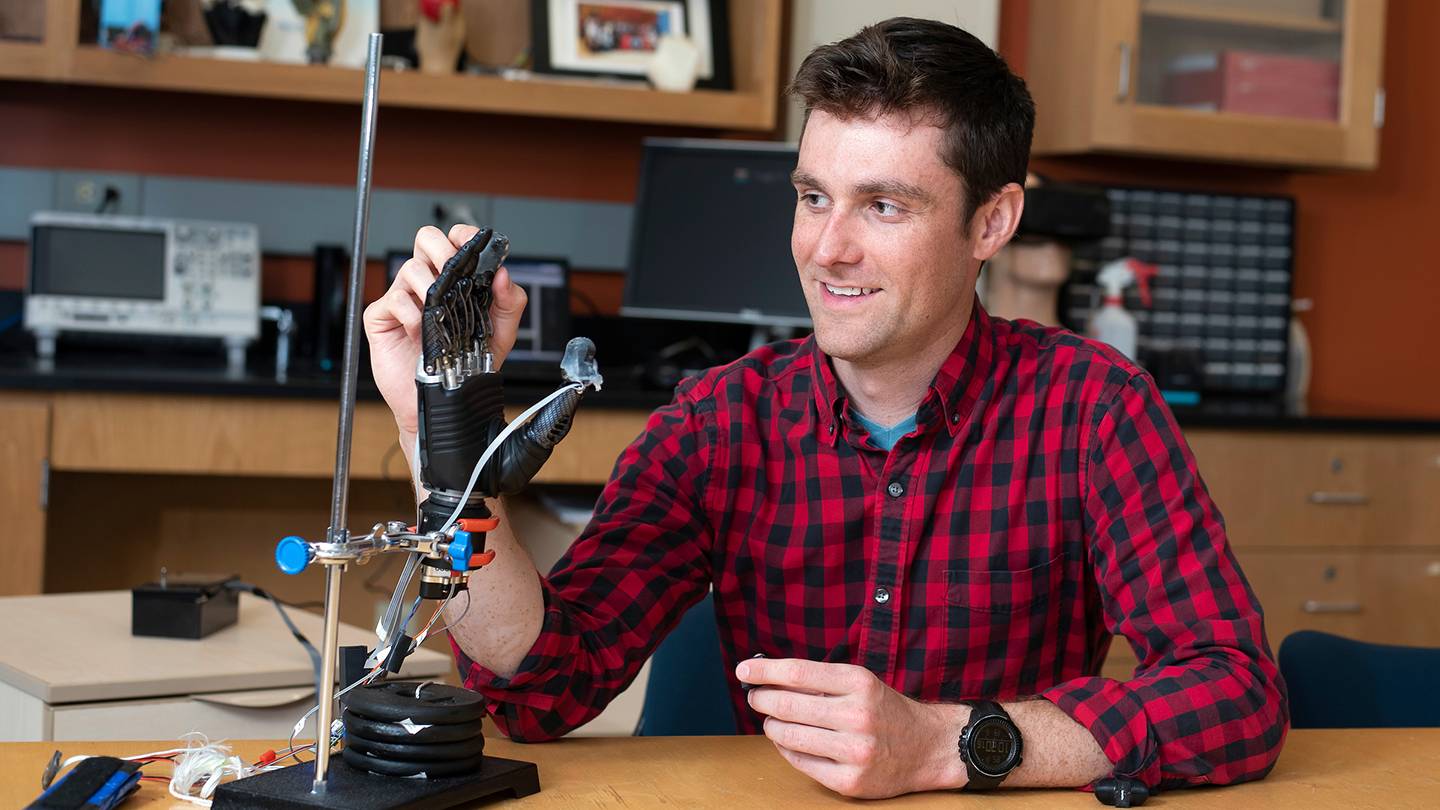
‘Electronic skin’ allows user to experience a sense of touch and pain; ‘After many years, I felt my hand, as if a hollow shell got filled with life again,’ amputee volunteer says.
6.20.18
Amy Lunday
Amputees often experience the sensation of a “phantom limb”—a feeling that a missing body part is still there.
That sensory illusion is closer to becoming a reality thanks to a team of engineers at Johns Hopkins University that has created an electronic skin. When layered on top of prosthetic hands, this e-dermis brings back a real sense of touch through the fingertips.
“After many years, I felt my hand, as if a hollow shell got filled with life again,” says the amputee who served as the team’s principal volunteer. (The research protocol used in the study does not allow identification of the amputee volunteers.)
Made of fabric and rubber laced with sensors to mimic nerve endings, e-dermis recreates a sense of touch as well as pain by sensing stimuli and relaying the impulses back to the peripheral nerves.
“We’ve made a sensor that goes over the fingertips of a prosthetic hand and acts like your own skin would,” says Luke Osborn, a graduate student in biomedical engineering. “It’s inspired by what is happening in human biology, with receptors for both touch and pain.

Luke Osborn interacts with a prosthetic hand sporting the e-dermis. Image credit: Larry Canner / Homewood Photography
“This is interesting and new,” Osborn adds, “because now we can have a prosthetic hand that is already on the market and fit it with an e-dermis that can tell the wearer whether he or she is picking up something that is round or whether it has sharp points.”
The work, published online in the journal Science Robotics, shows it’s possible to restore a range of natural, touch-based feelings to amputees who use prosthetic limbs. The ability to detect pain could be useful, for instance, not only in prosthetic hands but also in lower limb prostheses, alerting the user to potential damage to the device.
Human skin is made up of a complex network of receptors that relay a variety of sensations to the brain. This network provided a biological template for the research team, which includes members from the Johns Hopkins departments of Biomedical Engineering, Electrical and Computer Engineering, and Neurology, and from the Singapore Institute of Neurotechnology.
Video: American Academy for the Advancement of Science
Bringing a more human touch to modern prosthetic designs is critical, especially when it comes to incorporating the ability to feel pain, Osborn says.
“Pain is, of course, unpleasant, but it’s also an essential, protective sense of touch that is lacking in the prostheses that are currently available to amputees,” he says. “Advances in prosthesis designs and control mechanisms can aid an amputee’s ability to regain lost function, but they often lack meaningful, tactile feedback or perception.”
That’s where the e-dermis comes in, conveying information to the amputee by stimulating peripheral nerves in the arm, making the so-called phantom limb come to life. Inspired by human biology, the e-dermis enables its user to sense a continuous spectrum of tactile perceptions, from light touch to noxious or painful stimulus.
The e-dermis does this by electrically stimulating the amputee’s nerves in a non-invasive way, through the skin, says the paper’s senior author, Nitish Thakor, a professor of biomedical engineering and director of the Biomedical Instrumentation and Neuroengineering Laboratory at Johns Hopkins.
“For the first time, a prosthesis can provide a range of perceptions from fine touch to noxious to an amputee, making it more like a human hand,” says Thakor, co-founder of Infinite Biomedical Technologies, the Baltimore-based company that provided the prosthetic hardware used in the study.
The team created a “neuromorphic model” mimicking the touch and pain receptors of the human nervous system, allowing the e-dermis to electronically encode sensations just as the receptors in the skin would. Tracking brain activity via electroencephalography, or EEG, the team determined that the test subject was able to perceive these sensations in his phantom hand.
The researchers then connected the e-dermis output to the volunteer by using a noninvasive method known as transcutaneous electrical nerve stimulation, or TENS. In a pain-detection task the team determined that the test subject and the prosthesis were able to experience a natural, reflexive reaction to both pain while touching a pointed object and non-pain when touching a round object.
The e-dermis is not sensitive to temperature—for this study, the team focused on detecting object curvature (for touch and shape perception) and sharpness (for pain perception). The e-dermis technology could be used to make robotic systems more human, and it could also be used to expand or extend to astronaut gloves and space suits, Osborn says.
The researchers plan to further develop the technology and work to better understand how to provide meaningful sensory information to amputees in the hopes of making the system ready for widespread patient use.
Johns Hopkins is a pioneer in the field of upper limb dexterous prosthesis. More than a decade ago, the university’s Applied Physics Laboratory led the development of the advanced Modular Prosthetic Limb, which an amputee patient controls with the muscles and nerves that once controlled his or her real arm or hand.
See the full article here .

five-ways-keep-your-child-safe-school-shootings
Please help promote STEM in your local schools.
About the Hub
We’ve been doing some thinking — quite a bit, actually — about all the things that go on at Johns Hopkins. Discovering the glue that holds the universe together, for example. Or unraveling the mysteries of Alzheimer’s disease. Or studying butterflies in flight to fine-tune the construction of aerial surveillance robots. Heady stuff, and a lot of it.
In fact, Johns Hopkins does so much, in so many places, that it’s hard to wrap your brain around it all. It’s too big, too disparate, too far-flung.
We created the Hub to be the news center for all this diverse, decentralized activity, a place where you can see what’s new, what’s important, what Johns Hopkins is up to that’s worth sharing. It’s where smart people (like you) can learn about all the smart stuff going on here.
At the Hub, you might read about cutting-edge cancer research or deep-trench diving vehicles or bionic arms. About the psychology of hoarders or the delicate work of restoring ancient manuscripts or the mad motor-skills brilliance of a guy who can solve a Rubik’s Cube in under eight seconds.
There’s no telling what you’ll find here because there’s no way of knowing what Johns Hopkins will do next. But when it happens, this is where you’ll find it.
The Johns Hopkins University opened in 1876, with the inauguration of its first president, Daniel Coit Gilman. “What are we aiming at?” Gilman asked in his installation address. “The encouragement of research … and the advancement of individual scholars, who by their excellence will advance the sciences they pursue, and the society where they dwell.”
The mission laid out by Gilman remains the university’s mission today, summed up in a simple but powerful restatement of Gilman’s own words: “Knowledge for the world.”
What Gilman created was a research university, dedicated to advancing both students’ knowledge and the state of human knowledge through research and scholarship. Gilman believed that teaching and research are interdependent, that success in one depends on success in the other. A modern university, he believed, must do both well. The realization of Gilman’s philosophy at Johns Hopkins, and at other institutions that later attracted Johns Hopkins-trained scholars, revolutionized higher education in America, leading to the research university system as it exists today.


